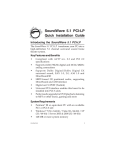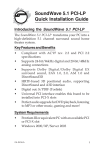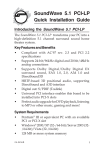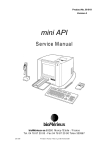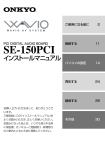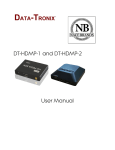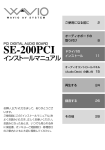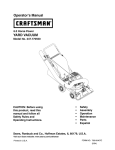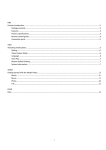Download SIIG SoundWave 5.1 PCI-LP Installation guide
Transcript
DP SoundWave 5.1 PCIe Quick Installation Guide Introducing the DP SoundWave 5.1 PCIe The DP SoundWave 5.1 PCIe transforms your computer into a high-definition 5.1 channel surround sound home theater system. Key Features and Benefits • • • • • • Provides high definition 5.1 channel surround sound Supports 24-bit/96kHz digital and 20-bit/48kHz analog connections Supports Dolby Digital/Dolby Digital EX surround sound, EAX 1.0, 2.0, A3D 1.0 and DirectSound 3D HRTF-based 3D positional audio, supporting DirectSound and A3D interface Provides S/PDIF Digital output (Toslink) Perfect audio upgrade for DVD playback, MP3 or other music, gaming and more System Requirements • • PCI Express enabled system with an available PCI Express slot Windows® 7 (32-/64-bit) / Vista (32-/64-bit) / XP (32-/64-bit) / Server 2003 & 2008 (32-/64-bit) 04-0631A 1 Package Contents • • • • • DP SoundWave 5.1 PCIe G9 DIN cable Spare low profile bracket Software CD Quick installation guide Layout J5 (CD-In) J7 (Aux-In) J3 (CD-In) Front (green) Surround (Black) Line-In Mic Digital Out (Toslink) Center/Subwoofer (yellow) Figure 1: DP SoundWave 5.1 PCIe 2 Audio Connectors MIC This connector provides microphone-in function. LINE In This connector provides analog line-in function. Digital Out (Toslink) Connect to digital input of an external audio device via Digital S/PDIF optical cable (cable not included). CD-In (J3, J5) Analog CD-In, connect to CD-ROM or DVD-ROM via audio cable (cable not included). Aux-In (J7) Connect to audio output device via audio cable (cable not included). Front Out (green) This connector provides front audio output, or you can connect one set of stereo speakers. Surround(black) This connector provides rear surround sound output. Center/Subwoofer Out (yellow) This connector provides center and subwoofer (LFE) audio output. 3 Hardware Installation Note: For low profile systems, replace the currently mounted bracket with the included low profile bracket. General instructions for installing the card are provided below. Since the design of computer cases and motherboards vary, refer to your computer’s reference manual for further information, if needed. Static Electricity Discharge may permanently damage your system. Discharge any static electricity build up in your body by touching your computer case for a few seconds. Avoid any contact with internal parts and handle cards only by their external edges. 1. 2. 3. 4. 5. 6. 7. 8. 4 Turn OFF the power to your computer. Unplug the power cord and remove the computer cover. Remove the slot bracket from an available PCIe slot. Carefully align the card to the selected PCIe slot, push the board down firmly, but gently, until it is well seated. Replace the slot bracket holding screw to secure the card. Connect one end of the audio cable from your CD/DVD-ROM to the CD-In on the soundcard. Replace the computer cover and reconnect the power cord. Make your speaker and device connections, then complete the driver installation on the next pages. Driver Installation Windows 7 (32-/64-bit) 1. 2. 3. 4. 5. Install the board, then boot up Windows. At the Windows desktop insert the driver CD. At the CD AutoPlay box, click Open folder to view files. Double click Setup (Application). Follow the on screen instructions to complete the installation. Windows Vista (32-/64-bit) 1. 2. 3. 4. Install the board, boot up Windows. At Found New Hardware, click Cancel. Insert the software CD. At the CD Auto Play window: click Open folder to view files. Double click Setup (Application). If CD Auto Play doesn't start: click Start, in the Start Search box, type D:\setup.exe, press Enter. (Change D: to match your CD/DVD-ROM drive letter) Follow the on screen instructions to complete the installation. Windows XP (32-/64-bit) 1. 2. 3. 4. Install the board, boot up Windows. At the Found New Hardware Wizard, click Cancel. Insert the software CD. Click Start, Run, type D:\Setup.exe, then click OK. (Change D: to match your CD/DVD-ROM drive letter) Follow the on screen instructions to complete the installation. 5 Windows Server 2003 & 2008 (32-/64-bit) 1. 2. 3. 4. Install the board, boot up Windows. At Found New Hardware..., click Cancel. Insert the driver CD. At the CD Auto Play window: click Open folder to view files. Double click Setup (Application). If CD Auto Play doesn't start: click Start, in the Start Search box, type D:\setup.exe, press Enter. (Change D: to match your CD/DVD-ROM drive letter) Follow the on screen instructions to complete the installation. To Verify Windows Installation 1. 2. 6 Check Device Manager to verify installation. Windows 7: Right click Computer, click Manage, then click Device Manager. Windows Vista: Right click Computer, click Manage, click Continue, then click Device Manager. Windows XP / Server 2003: Right click My Computer, click Manage, then click Device Manager. Windows Server 2008: Right click Computer, click Manage, double click Diagnostics, then click Device Manager. Double click Sound, video and game controllers, Envy24 Family Audio Controller WDM should be displayed. Uninstalling the Soundcard Driver If you want to uninstall the driver from the system, it's best to do so before removing the card from the system. Use the same setup program that you used when installing the driver, however, at the appropriate time select the Uninstall Device Driver option and follow the on screen instructions to uninstall the driver. Enable Windows Audio Windows XP, Server 2003 and Server 2008 systems that do not have a fully operating sound card may require enabling Windows Audio support to support the DP SoundWave 5.1 PCIe. Windows XP / Server 2003 & 2008 1. 2. 3. Click Start, Control Panel, Sounds and Audio Devices. At the Sounds and Audio Devices Properties box check Enable Windows Audio, then click OK. Click Yes to restart Windows. Sounds and Multimedia Properties Audio Configuration Windows 7 1. 2. 3. 4. Click Start, Control Panel. Click Hardware and sound icon. Click Manage audio devices. Select the Playback tab, right click Envy24 Family Audio Controller WDM, click Set as default device. 7 Windows Vista 1. 2. 3. Click Start, Control Panel. Click Classic View, double click the Sound icon. At Playback tab, select Envy24 Family Audio Controller, click Set as default device. Windows XP / Server 2003 & 2008 1. 2. 3. 4. 5. Click the Start button. Click Control Panel, Sounds and Audio Devices. Click the Audio tab. In the Sound Playback and Sound Recording drop down box, select Envy24 Family Audio Controller WDM. Click OK to save the changes. Enable Digital CD Playback Windows XP / Server 2003 / 2008 1. 2. 3. 4. 8 Right click My Computer, click Manage, then click Device Manager. Double-click DVD/CD-ROM drives, then double click your DVD or CD-ROM drive, then click the Properties tab. Check Enable digital CD Audio for this CD-ROM device, then click OK. If prompted, restart Windows. Otherwise, your drive is ready for use. Audio Deck Audio Deck is an easy to use, full featured audio utility that allows you to adjust audio outputs, recording, sound effects and surround sound support to match your taste and mood. Quick Start Icon During driver installation, the Audio Deck quick start icon is placed in the taskbar by the system clock. Click on the icon to open the Audio Deck Control Panel. Control Panel S/PDIF Control Close Speaker Playback Recording Sound Effects Master Volume Control KalaOK Advanced Controls Information Stereo Link Mute Change Channel • • • S/PDIF Control: Sets Digital output (Toslink) signal source Speaker: Sets the volume for the various speakers Playback: Adjusts the volume of each output device 9 • • • • • • • • • • 10 Recording: Selects the recording source and controls it's recording level Sound Effects: Includes Equalizer with 4 presets and you can customize your own settings, QXpander, Environments. This tab appears only after selecting Immezio 3D Effects Enable in the Advanced Controls window. Important: Sound Effects not supported in Windows XP (64-bit) and Windows Server 2003 (64-bit). KalaOK: Adjusts mid-range sound volume Karaoke enhancement Advanced Controls: Sets sound parameters for the soundcard Information: System and driver information is displayed here Change Channel: Displays the current channel mode. Click any button to access Channel Setup to change channel mode. Note: 4-channel mode is supported in XP and Windows Server 2003. Master Volume Control: Adjusts the system volume of the left and right channels Stereo Link: Adjusts the left and right channels individually Mute: Turns the system sound On/Off immediately Close: Click to close the Control Panel S/PDIF Control • • • • S/PDIF Out Enable: Turns ON/OFF the Optical Digital Out AC3 or PCM auto select (48kHz): With this setting all of the digital sources (wave, midi) are played over the digital output. This setting is also used when you want to send encoded AC3 streams to an external decoder AC3 Only (48 kHz): This setting is only used when you want to send encoded AC3 streams to an external encoder. PCM Only: This setting is only for digital sources (wave, MIDI), which are played over digital output 11 Speaker Here you can set the volume for the various speakers. All speakers can be muted by clicking the check button above the speaker icon. Playback Here you can adjust the playback settings for various resources. Next Page • • 12 Wave: Sets the volume for WAV sound (WAV, MP3, WMA) SW Synth: Sets the volume for MIDI sound from software synthesizer • • • • • • • CD Player: Sets the volume for analog output of the CD/DVD-ROM MIC: Sets the volume for microphone playback Line In: Sets the volume for analog playback of Line In sound (no playback through Digital Optical Out) CD In: Sets the volume for analog output of CD In Wave Table: Sets the volume for MIDI sound from wavetable daughter board (not included) Aux: Sets the playback volume for Aux In PCM SPDIF: Sets the volume for S/PDIF Out Recording In the recording menu you can choose which source the sound card will use to record. Source Column • • • Source Column: Set the volume for recording signal which the user has selected DC Remove: Reduces interference when recording through the microphone. 20dB boost: Increases the sensitivity of the microphone by 20dB 13 Sound Effects This panel is enable by selecting Immezio 3D Effect Enable in Advanced Controls. Note: Not supported in XP (64-bit) & Server 2003 (64-bit). • • • • Equalizer: Set the volume of different frequencies independently Preset: Select from the pre-configured equalizer settings QXpander: Adjusting the sound expanding effect Environmental Modeling: Select different environment effect models KalaOK KalaOK: Adjusts volume of mid-range sounds. 14 Advanced Controls In the advanced controls menu you can set system parameters for the DP SoundWave 5.1 PCIe. • • • • Language: Select Auto, English or Chinese Center/LFE Swap: Swap center speaker and subwoofer speaker outputs Stereo Expander: This setting duplicates the front channel stereo sound to the other surround sound channels Emmezio 3D Effects Enable: Offers 3D audio for computer games or musical playback in multi-channel mode. Note: Immezio 3D Effects not supported in Windows XP (64-bit) and Windows Server 2003 (64-bit). 15 Speaker Test Channel Setup • • Speaker Test Speaker Test: Tests the position of your 2, 4 or 6 channel speaker system. Click on a speaker icon and you will hear a short note. Speaker test works with speakers connected into the G9 DIN audio connector only. Speaker Test not intended for Optical S/PDIF or surround sound speakers operating through a digital decoder box Channel Setup: Click on the desired icon to change the speaker mode. The active mode will display to the left of the menu. Information System and driver information is displayed here. 16 Blank Page 17 Blank Page 18 Technical Support and Warranty QUESTIONS? SIIG’s Online Support has answers! Simply visit our web site at www.siig.com and click Support. Our online support database is updated daily with new drivers and solutions. Answers to your questions could be just a few clicks away. You can also submit questions online and a technical support analysts will promptly respond. SIIG offers a 5-year manufacturer warranty with this product. Please see our web site for more warranty details. If you encounter any problems with this product, please follow the procedures below. A) If it is within the store's return policy period, please return the product to the store where you purchased it. B) If your purchase has passed the store's return policy period, please follow these steps to have the product repaired or replaced. Step 1: Submit your RMA request. Go to www.siig.com, click Support, then RMA to submit a request to SIIG RMA. Your RMA request will be processed, if the product is determined to be defective, an RMA number will be issued. Step 2: After obtaining an RMA number, ship the product. • Properly pack the product for shipping. All software, cable(s) and any other accessories that came with the original package must be included. • Clearly write your RMA number on the top of the returned package. SIIG will refuse to accept any shipping package, and will not be responsible for a product returned without an RMA number posted on the outside of the shipping carton. • You are responsible for the cost of shipping. Ship the product to the following address: SIIG, Inc. 6078 Stewart Avenue Fremont, CA 94538-3152, USA RMA #: • SIIG will ship the repaired or replaced product via Ground in the U.S. and International Economy outside of the U.S. at no cost to the customer. 19 About SIIG, Inc. Founded in 1985, SIIG, Inc. is a leading manufacturer of IT connectivity solutions (including Serial ATA and Ultra ATA Controllers, FireWire, USB, and legacy I/O adapters) that bridge the connection between Desktop/ Notebook systems and external peripherals. SIIG continues to grow by adding A/V and Digital Signage connectivity solutions to our extensive portfolio. All centered around the distribution and switching of A/V signals over CAT5/6, these products include matrix switches, distribution amplifiers, extenders, converters, splitters, cabling, and more. SIIG is the premier one-stop source of upgrades and is committed to providing high quality products while keeping economical and competitive prices. High-quality control standards are evident by one of the lowest defective return rates in the industry. Our products offer comprehensive user manuals, user-friendly features, and most products are backed by a lifetime warranty. SIIG products can be found in many computer retail stores, mail order catalogs, and e-commerce sites in the Americas, as well as through major distributors, system integrators, and VARs. PRODUCT NAME DP SoundWave 5.1 PCIe FCC RULES: TESTED TO COMPLY WITH FCC PART 15, CLASS B OPERATING ENVIRONMENT: FOR HOME OR OFFICE USE FCC COMPLIANCE STATEMENT: This device complies with part 15 of the FCC Rules. Operation is subject to the following two conditions: (1) This device may not cause harmful interference, and (2) this device must accept any interference received, including interference that may cause undesired operation. THE PARTY RESPONSIBLE FOR PRODUCT COMPLIANCE SIIG, Inc. 6078 Stewart Avenue Fremont, CA 94538-3152, USA Phone: 510-657-8688 DP SoundWave 5.1 PCIe is a trademark of SIIG, Inc. SIIG and the SIIG logo are registered trademarks of SIIG, Inc. Microsoft andWindows are registered trademarks of Microsoft Corporation. All other names used in this publication are for identification only and may be trademarks of their respective owners. May, 2010 Copyright © 2010 by SIIG, Inc. All rights reserved.




















